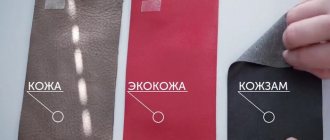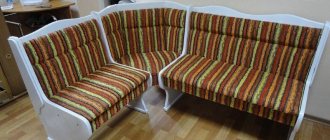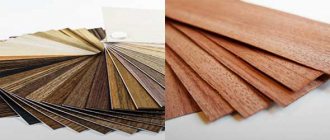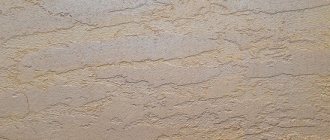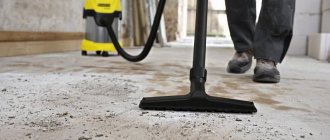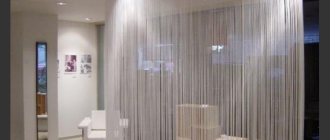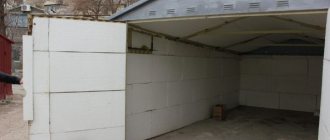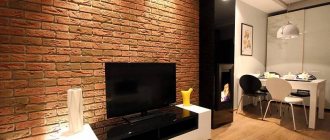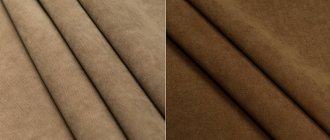0
8084
Upholstered furniture for furnishing residential and public premises always creates comfort in the surrounding space. One of the main indicators of its functionality, harmony and environmental friendliness is the upholstery material. Today, artificial suede for furniture is considered the most popular type of textile. The fabric, in addition to its presentable appearance, has excellent mechanical, physical, chemical properties, a wide range of color shades, so it always looks impressive.
What is the difference between artificial suede and natural one?
To learn how to distinguish artificial fabric from natural fabric, you should have an idea about them, as well as know what material options exist. Natural suede is leather that has been treated with fats. The fake material is made from fabric with suede pile, impregnated with glue.
Artificial suede is practically indistinguishable from natural leather in appearance.
A high-quality natural product has a soft, pleasant-to-touch pile. It has a high cost. This is due to the high costs of its production. Natural material can be determined by a number of criteria:
- porous structure;
- trace from stroking the fabric;
- soft touch;
- specific smell;
- there is no fabric on the reverse side;
- high price;
- quickly absorbs moisture.
This upholstery can give a stylish, noble and “expensive” look to furniture.
Being able to identify the differences between natural and artificial materials will help you save money. When buying furniture, focusing only on cost is not logical. An unscrupulous seller can pass off synthetic textiles as natural, and this will significantly increase the cost of the product as a whole. The artificial material is homogeneous in structure and smooth.
Many manufacturers call this material “new generation technology.”
On the reverse side of the product there is fabric. Touching the material does not leave a dark finger or hand mark. The smell is synthetic and pungent. Another simple way to distinguish a non-natural surface is water. Synthetic suede practically does not absorb moisture. All the characteristics inherent in a suede substitute will allow you not to overpay several times for a piece of furniture.
Which is better: flock or faux suede
Flock is a non-woven material with a pile on the front side. Due to its soft and pleasant texture, flock is widely used in the manufacture of upholstered furniture. The fabric fits perfectly into any room design and has a number of advantages:
- resistance to mechanical stress (friction, contact with pets’ claws);
- immunity to chemicals;
- the ability to maintain the original pattern, brightness and saturation for a long time;
- hypoallergenic;
- ease of operation and cleaning;
- long service life.
When choosing fabric for upholstering a sofa, many consider and compare these two options.
- For people who want to get comfort and practicality at a low price, it is best to give preference to flock. The material has a variety of shades and easily fits into the interior.
- Those who value stylish and luxurious textures are recommended to opt for faux suede. For a relatively low price you can buy a sofa worthy of rooms with the richest decorations.
Before making a choice in favor of one of these two materials, you need to study their characteristics in detail and understand whether the product will meet specific conditions.
Modern technologies allow manufacturers to create artificial analogues that are not much different from natural materials. Such canvases not only decorate the premises, but also add warmth and comfort to them.
Characteristics of artificial suede
The demand for artificial materials is driven by the struggle to increase the number of animals. Initially, the natural material was made from chamois leather. Later, the skin of deer, goats, sheep, and antelopes began to be used for production. But since the resulting material is expensive and its wear resistance is average, we began to think about how to reduce costs.
Faux suede is a unique combination of polyester and natural cotton.
A cheaper analogue was launched into production, which in turn became popular due to its wear resistance and high technical characteristics. Upon visual assessment, the material is no different from artificial. And in some features they even surpass it.
Description
Let's find out the main features of artificial suede as a type of furniture upholstery.
Many manufacturers call this material “new generation technology.” Faux suede is a unique combination of polyester and natural cotton. These two main components are often impregnated with a special Teflon liquid, which significantly increases the strength and wear resistance of the material.
Artificial suede is a unique soft material that quite reliably imitates its natural counterpart. A person who does not understand the intricacies of various materials will not understand what kind of suede the sofa is upholstered in - real or artificial, until he looks at the price. Naturally, real suede will cost much more.
This is what faux suede for furniture looks like
The material is perfect for upholstering any upholstered furniture: sofas, armchairs, chairs, banquettes, and poufs look luxurious and noble in “clothes” made of artificial suede. A room with such furniture immediately becomes more luxurious, more status, and makes an impression.
In many respects, the artificial analogue is superior to its natural “brother”. If natural suede is capricious and very expensive, then artificial suede is strong and durable, and its cost is several times less. Artificial suede is not afraid of small scratches and creases. While these defects can make the surface of a natural material unsightly, they will not even be visible on an artificial analogue. Follow the link to learn how to distinguish natural suede from artificial suede.
What is it made of, fabric composition
An analogue of natural suede has a simple composition, including:
- cotton;
- polyester;
- glue.
The material is perfect for upholstering any upholstered furniture.
The glue used is PVA based. After making the fabric, it is coated with Teflon. This provides protection from moisture and dirt. Processing provides additional opportunities - suede can be washed. The use of detergents does not affect the properties of the fabric. The only thing you should do after washing is tidy up the pile.
Take care of suede furniture.
A sofa made of artificial suede should be brushed after drying. If the fabric feels hard to the touch, this indicates that it has been laminated or glued. This procedure is performed in order to rid the material of bubbling. It also eliminates stretching of textiles and the formation of folds.
Use a vacuum cleaner to clean the sofa.
Application area
Most often, artificial suede is used for furniture upholstery. This upholstery gives a chic look to even the simplest model of sofa or chair. True, it requires some care, simple, but correct.
Home textiles made from artificial suede are also popular: napkins, curtains. Curtains made from such fabrics are especially impressive and authentic. We also produce a variety of accessories made from artificial suede: bags, backpacks, cases. Such belts or belts look unusual. This type of suede is often used for car upholstery. It looks impressive and expensive.
Fashionable items are made from artificial suede: skirts, especially pencil-type models, vests, sleeveless vests, trousers, jackets, dresses, cardigans, jackets, even sundresses. It is also used for outerwear. Now sheepskin coats, coats, men's and women's jackets made of colored faux suede are incredibly popular. They are practically no different from models made from a natural analogue.
Shoes made of artificial suede are popular: shoes, shoes, boots. True, they require more careful care.
What is faux suede called?
Non-natural suede is also called eco-suede. This is not quite the correct name, but manufacturers often use these words as synonyms. All eco-suede is an artificial material. But not everything artificial is eco-friendly. It is understood that if materials that do not harm the environment were used to produce the fabric, then the material is eco-friendly.
This type of material is much easier to care for than its woven counterpart.
All other products are correctly called non-natural suede elements. The material used for upholstery can also be called Alcantara. Some manufacturers may present this as a new product among upholstery products. But in essence, this is ordinary synthetic suede. Therefore, you should pay attention not to the name of the material, but to the method of its manufacture, type.
Natural and artificial suede - what is it?
Natural suede has been popular since ancient times. Initially, it was obtained by fat tanning the skin of a black goat, or chamois, hence the name: French. chamois - chamois, passed into the Russian language through the Polish language - zamsz. Nowadays it is made from the skin of any small animal. This is a fairly expensive material from which outerwear, bags, belts, gloves, and shoes are made. It is distinguished by high strength, ductility and abrasion resistance, and has the smell of genuine leather.
Expensive natural suede has been replaced by artificial suede. It is also wear-resistant, especially with additional impregnation with water-repellent agents.
Types of material
Among the types of manufacturing, 2 types of varieties can be distinguished:
- woven;
- non-woven
The woven material is very tear-resistant anywhere in upholstered furniture.
Both types look no worse than similar non-synthetic material. A piece of furniture such as a suede sofa requires attention and proper care. In the case of artificial upholstery, everything is simpler.
Woven method
This type is not very practical for upholstery. More often, such textiles are used for the production and design of clothing and shoes. Covers are made from it for sofas and armchairs, which perfectly cope with the functions assigned to them. The principle of production of woven covering is splitting microfiber threads.
The sofa upholstery does not stretch or deform during use.
At first, the appearance of the product looks respectable, but it quickly loses its properties. The quality of the woven product can be improved by increasing the microfiber processing time. During the work process, the fibers turn out to be of different lengths. The longer the manufacturer carries out the operation, the higher the quality of the suede obtained.
Non-woven method
Non-woven material is obtained by applying an adhesive composition to a specially prepared surface. After applying the layer, the fiber is sprayed. If Teflon is added at the same time, the resulting material is much stronger.
Suede for fabric-based furniture is more valued.
For the base, synthetics and knitwear are used. It must be primed so that the glue can be applied in an even layer. The Teflon coating can also be applied after the pile has been sprayed. But this must be done without fail, since this is the main way to protect the coating from moisture and dirt.
Use and care
Suede-like fabrics are used in many areas - from clothing production to furniture upholstery.
double-sided stretch suede
Cloth
Suede fabric is often used for sewing winter and autumn outerwear - men's and women's coats, jackets, jackets. Suede suits, jackets and coats are made from jacket material on a cotton or knitted basis. The fabric is primed so that it is not saturated with glue, then a layer of glue and artificial polyamide or viscose fiber, crushed in an electrostatic field, are applied. To protect against moisture, the surface of the fabric is impregnated. Sometimes the pile is given a certain direction.
Suede clothing is very cozy and soft to the touch, fits your figure well, emphasizing all its advantages. Women's skirts, trench coats and jackets look especially beautiful and stylish. It is better to choose clothes in light colors, since adhered particles of dust, lint or thread will be very noticeable on black fabric.
Features of cutting and sewing
Basically, in the process of making clothes, suede fabric behaves the same as regular fabric, but it has some features.
- When selecting models, it should be taken into account that suede on a knitted base is softer, drapes easily and looks lighter. Therefore, it is better to sew dresses, blouses, and skirts from it. And the cotton backing makes the fabric denser, so it will hold its shape well and can be used for making costume group clothing.
- When cutting, you need to use regular scissors.
- On dense suede fabric, holes remain from punctures with a needle, so you need to be careful when basting, and also try not to rip the stitched fabric.
- The direction of the pile also has a peculiarity: if the piles are directed downwards, the fabric will have a slight shine, if they go upwards, the color will be brighter.
- Use sharp needles, the same type as for denim.
- It should be borne in mind that artificial suede does not allow air to pass through very well, so when sewing from it it is better to choose loose styles and avoid too tight ones.
- This fabric does not fray, so it does not require additional processing of seams. For beauty, you can overlock them or use zigzag scissors when cutting.
Care
Clothing made from this material is easy to wash and retains its original appearance.
- It is soaked for a short time in a soap solution (the water temperature should be between 35-40 degrees) and washed without much effort.
- You can’t wring it out, you can only blot it with a towel and then hang it on a hanger in a warm place to dry.
- Periodically it is necessary to blot the item with a towel to prevent smudges from forming.
- There is no need to iron it. If creases still form, you can iron them from the wrong side through the fabric.
Accessories and shoes
Faux suede is used primarily for women: shoes, boots, and popular high stocking boots are made from stretch suede.
This fabric is also widely used for sewing bags, as it is soft and easy to mold and drape.
Care
- Shoes and bags are cleaned using a dry sponge or a sponge soaked in soapy water, depending on the degree of contamination.
- After drying, use a soft brush to give the fibers the desired direction.
- Low-quality artificial suede can wear out on the folds and even crumble under light mechanical stress. Before buying clothes and shoes, you need to make sure that the products are of good quality.
We recommend
New shoes and bags must be impregnated with a special water-repellent compound.
Furniture
Suede fabric is very popular as a material for upholstery due to its properties:
- Thanks to wear resistance, sofas and armchairs will delight you with their magnificent appearance for a long time. This upholstery is used not only for home furniture, but also for office furniture;
- This furniture looks very noble and is suitable for any interior. Will bring a feeling of warmth and comfort to the room;
- Suede furniture can be used in living rooms and dining rooms - thanks to special treatment, it will repel accidentally spilled liquids.
- thanks to a wide selection of textures, colors and patterns, you can choose furniture for any style of room decoration;
- the upholstery of the sofa will not stretch or deform, even if you sit on it often - the suede fabric is very elastic and easily restores its shape.
Tips for choosing
Artificial raw materials are becoming increasingly popular. Since manufacturers can be tricky with furniture upholstery, you should be able to choose the right product from it. Synthetic suede stands out among natural textiles. First of all, it's the price. For the buyer, the cost of the furniture and its appearance are important. Material costs determine the price of furniture. When the main criteria are determined: type and cost, you should make sure that the material chosen is of high quality.
Choose quality suede if you have animals in your home.
If the choice is made in the direction of artificial suede, then you should know that it is produced in different ways. The quality of the material and its service life depend on this. A product made without complying with all production requirements will quickly lose its appearance. It is important to pay attention to the thickness of the material. The higher the density of the textile, the longer the piece of furniture will last. But at the same time, you should not choose too thick fabrics, since a suede sofa will look rough.
According to the texture, three types can be distinguished:
- porous;
- smooth;
- with perforation.
If the fabric has unevenness, it looks like genuine leather. The material easily allows moisture and air to pass through. Smooth coating is characterized by low cost, but it requires careful maintenance. The coating is often chosen based on the traffic flow of the room. The smooth coating is easy to clean.
There are many colors of suede available today.
Embossing looks expensive, but it is better to place a sofa with such upholstery in an office or library. The choice of color does not affect the quality of the product in any way. Therefore, there are quite a lot of options. The color should be decided on the basis of the overall interior of the room where the sofa will be located.
Properties of natural suede
Due to its natural origin, suede is considered a hypoallergenic and wear-resistant material. High-quality suede products last a long time, do not accumulate static electricity, allow air to pass through well and do not fade over time. The material is resistant to deformation and moisture.
What does the fabric look like?
Externally, the material looks elegant and noble. The soft and uniform velvety surface is pleasant to the touch. The fabric can be thin, which means it fits well and fits in beautiful neat folds, or thick, which means it can be denser and more shaped.
Does suede stretch or not?
Compared to genuine leather, suede is a more pliable and soft fabric. Thanks to its elastic properties, suede shoes break in well and fit perfectly on the foot. However, if the selected suede shoes or boots are short in length, tight, or do not fit well, it is not recommended to buy such products. If you experience only slight discomfort after buying new shoes, you can get rid of it at home using a special shoe stretcher.
Use Cases
Most often, consumers choose suede as upholstery for furniture. If the sofa or chair in the room has lost its appearance, but the structure is strong and can be used, you can reupholster it. Today, performing such a procedure is easier and cheaper than purchasing new interior items.
Unique strength characteristics make furniture with such upholstery very durable.
In a textile store you can choose the appropriate fabric option. Many buyers believe that choosing material in a store is easier and more reliable than choosing a finished structure. The store provides the opportunity not only to examine the fabric from the front and back layers, but also to consult with the manager.
This fabric has much more advantages than disadvantages.
If you are purchasing a sofa, you should ask the seller to demonstrate the material. Typically, manufacturers attach a piece of fabric to the inside of the structure. And if you don’t focus attention on this, then consultants may simply remain silent about this feature.
When coated with a special impregnation, furniture suede becomes less dirty.
Faux suede is often used by shoemakers who specialize in handmade shoes. High-quality material will be in no way inferior in characteristics to natural material, while the cost of shoes and sneakers can be significantly reduced. The same parameters can be applied to the production of clothing.
Light suede requires special care.
Textiles easily show themselves in work. It is easy for the cutter to work with it. With proper care, a jacket or jacket will serve its owner for a very long time. Suede can be used as a decorative element. They can partially repair furniture and give old furniture a new look.
The difference between suede and other materials
Suede products are valued for their sophisticated appearance, as well as durability, strength and hypoallergenicity. However, the range of textile products includes many analogues of suede, which differ from natural fabric in both positive and negative properties.
How to fake suede
Sometimes unscrupulous sellers, wanting to earn more, pass off artificial material as natural. To avoid falling for the tricks of such sellers, when purchasing products, pay attention to the parameters indicated in the table.
| Properties | Natural suede | Fake |
| Appearance | It will never be perfectly smooth or evenly colored. | The paint lies evenly and there are no flaws on the surface. |
| Pile | If you run your hand over the surface, the pile will change texture and color. Its surface will be very soft and velvety. | The pile always remains the same and feels a little rough. |
| Wrong side | Soft and pleasant, reminiscent of velvet paper to the touch. | Has a fabric base. |
| Exposure to moisture | Absorbs water. | Repels moisture. |
| Tactile sensations | It gets warmer after a short touch with your hand. | Remains cold after contact with skin. |
| Tag | Quality products always have a sample of the material. | There is no sample tag. |
| Smell | Smells like genuine leather. | It either emits a synthetic smell or no smell at all. |
| edge | The section shows a homogeneous structure. The edge is processed using a special method without bending. | If you carefully examine the edge, you will notice a thin layer of fabric. The cut can be folded. |
| Creases | Quickly returns to its original form if the material is bent. | There may be creases on the surface. |
The difference between natural suede and artificial or eco-suede
You can find 2 types of eco-suede on sale:
- a less strong and durable material created by gluing fibers to a dense base;
- a more wear-resistant fabric made using looped synthetic threads.
Unlike their natural counterpart, artificial fabrics have the following advantages:
- a humane manufacturing method, since no animals suffer during the production of the fabric;
- more budget option;
- the paint applies to the material correctly and evenly;
- Thanks to synthetic impregnations, products are more durable and last longer.
Despite these advantages, eco-suede, like natural fabric, requires careful care and does not tolerate moisture. In addition, the material does not “breathe” well, retains heat or cold, and can cause skin reactions. In addition, cheap versions of artificial suede have a specific synthetic smell, and their surface wears off quickly.
How is it different from genuine leather?
As you know, natural suede and leather are similar materials, as they are made from animal skins. Suede is very different from leather in appearance and production method. Leather products, like suede ones, require careful care, are flexible and durable, do not cause allergies and are highly breathable. However, smooth leather is able to repel moisture, which is not inherent in natural suede.
How to distinguish from velor, flock and nubuck
Unlike natural suede, velor, flock and nubuck are rougher and tougher materials.
Velor can deteriorate even with a single exposure to moisture or detergent. The pile is long and easily changes direction. Fingerprints are always visible on the surface of the velor. There are always creases in the material, and the pile actively attracts dust, wool and threads.
Nubuck is a less durable material. In appearance it is smoother than suede. Nubuck wears out quickly, loses its shape and color. After a short period of use, creases and cracks appear on the surface.
Flock is considered a durable material, and its properties resemble velvet. Unlike suede, its fabrics have a shorter pile, obtained by spraying small particles of wool or cotton. The material absolutely cannot withstand exposure to moisture, becomes highly electrified and wrinkles.
How is suede different from split leather?
Despite the fact that split leather, like suede, is of a natural nature and is made from animal skins, it also has characteristic differences. If suede is made from the top layer of hide, then split leather is made from melon or hide layer. Split wood has a perfectly smooth, velvety surface, as it is processed with a knife and special compounds. Unlike suede, the material does not restore its shape well, lasts much less time and does not withstand exposure to moisture at all.
Care instructions
In order for a suede product to last a long time, it needs to be properly cared for. Whatever properties suede has, it should be remembered that it is fabric. She tends to get dirty. This especially applies to light shades. Eco-materials are easy to care for, but they should not be exposed to aggressive agents.
Suede upholstery will be much more difficult to clean.
If we are talking about curtains, curtains, then they can be washed. This procedure must be performed manually. Machine washing involves mechanical stress that the material may not withstand. The ideal mode would be hand washing, without twisting. Products after washing must be placed on hangers. Proper and careful care will extend the life of the suede product.
Harsh household products are not suitable for cleaning a suede sofa.
It is necessary to avoid the appearance of greasy stains on the surfaces of such fabrics. They eat into the product and are impossible to remove. For this reason, sofas, chairs, and other products made of artificial suede are not installed in the kitchen. If a greasy formation does appear on the fabric, then the only option is to remove this section of the coating and replace it with a new piece of material.
Manufacturers recommend dry cleaning only for suede products. Various designs, items of clothing, shoes, furniture that contain inserts, or are entirely made of artificial suede, are accompanied by instructions. You can ask the seller for care recommendations.
Since it is difficult to independently determine the method of making the material, it is necessary to take advice from manufacturers. They know the type with which the product is made, which means the instructions for caring for the fabric will be correct. With proper care, the fabric will remain in its original form long after purchase.
Faux suede for a sofa: pros and cons
The advantages of furniture upholstery made from faux suede leather are as follows:
- Maximum resemblance to natural material.
- The ability to create a feeling of expensiveness.
- Reasonable price.
- A wide range of colors allows you to choose a sofa or other upholstered furniture to suit absolutely any interior.
- Coating strength and high wear resistance.
- Long service life.
- The presence of Teflon impregnation, which repels various contaminants.
- Immune to static electricity.
- Resistant to sunlight, no tendency to fade.
- Environmental Safety.
- The ability to drape perfectly (fit to various surfaces).
- Uniform and homogeneous coloring.
- The absence of all kinds of defects characteristic of natural fabric: scratches, cracks, pores.
In addition, it has an unusual property: in warm seasons it emits coolness, and in winter – warmth.
In addition to its advantages, the material has several disadvantages:
- the presence of a tensile strength, for example, artificial suede cannot withstand contact with animal claws;
- the ability to quickly get dirty in the absence of Teflon treatment (this applies to products with light shades);
- the need to follow several rules when cleaning;
- attracting animal hair, as well as other foreign hair fibers.
Suede sofa options in the photo
Production of material
Artificial fabric is made in two ways: woven and non-woven.
- Woven is a high-quality and expensive method. In this case, the material is made from special threads. The result is soft and dense fabric. Using this method, a base is made, from which jackets, shirts, trousers are subsequently sewn, used as upholstery, etc. However, despite all the advantages, the material made in this way is not practical.
- Non-woven - polyester and cotton are glued together using the cold or hot method. Moreover, the first fiber in artificial suede is about 30%, and the second - 70%. Fabric made using this method is used for upholstery. Non-woven material is much easier to care for than its woven counterpart.
p, blockquote 5,0,1,0,0 —>
It is necessary to select a product according to the production method depending on the needs of the buyer.
Reviews
Alexander, 47 years old
p, blockquote 14,0,0,0,0 —>
“My wife and I purchased the sofa. We were determined to get one that would last for many years. We thought about taking a textile covering, but the consultant at the store recommended taking artificial suede, since the material is much cheaper and more durable. We quickly selected furniture based on color and design and brought it home the same day. We've been using it for over six months now. There are no complaints about the upholstery - the color is not lost, care is easy. I note that the product is soft, so it’s pleasant to sit and use. I think we made the right choice.”
p, blockquote 15,0,0,1,0 —>
Ekaterina, 34 years old
p, blockquote 16,0,0,0,0 —>
“We recently moved into a house and need to furnish it with furniture. We decided to buy sofas and armchairs in a specialized store in our city. We thought for a long time about the upholstery material, since our family has children and pets. In the end, we chose faux suede on the advice of a close friend who had an identical one. And I'm very pleased. We've been using it for about a year. The sofa looks great despite daily use."
p, blockquote 17,0,0,0,0 —>
p, blockquote 18,0,0,0,0 —>
“I’ve heard about suede sofa cover for a long time, but I didn’t dare buy it. I took a risk and was not mistaken. The material looks good, complements the interior favorably, and with good care lasts a long time. It is incredibly easy to care for. Buy it, you won’t regret it.”
p, blockquote 19,0,0,0,0 —>
p, blockquote 20,0,0,0,1 —>
“My sister recently covered all the upholstered furniture with faux suede. I decided that this option would suit both my wife and I. Our sofa is not new, but functional. We bought extra material, covered it and even had enough for two chairs. Excellent fabric, no complaints."
Artificial suede is a modern material that is widely used in furniture production. This material has many advantages, but it also has its disadvantages. Artificial suede is practically indistinguishable from natural leather in appearance, therefore it can give a stylish, noble and “expensive” look to furniture.
One of the main disadvantages includes some difficulties in caring for furniture with this upholstery. However, first things first. In this article, let's look at all the pros and cons of artificial suede as an option for furniture upholstery, and find out what people who have already acquired such furniture say.
pros
Let's consider the “strengths” of this upholstery material.
Artificial suede has the special advantage that this material is very durable and wear-resistant. If you treat the furniture carefully, it will serve without complaints for many years, remaining outwardly presentable all this time.
This is a very durable material. Artificial suede is very difficult to tear, stretch, or otherwise deform mechanically. Unique strength characteristics make furniture with such upholstery very durable.
In addition to direct mechanical impact, artificial suede is also resistant to UV radiation and other negative factors. It does not fade, does not fade, and does not lose its decorative and technical characteristics due to humidity or cold in the house.
On video - artificial suede for furniture:
